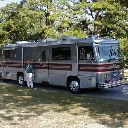Go to...  | Start A New Topic  | Search  | Notify  | Tools  | Reply To This Topic  |  |
 |
What is the output of typical solar cell panels? Also, which batteries are they usually wired to charge, chassis, house, or both? I acquired panels on my Barth purchase. The control panel only indicates an amp or two of charge, but the gauge scale goes much much higher. Since I am afraid of heights, I have not actually looked at the actual panels, so do not know the size. | ||
|
I guess you did not get a manual.? I will wait the posts you get as I am interested too. I know slow charge is what they do, but like a TURTLE they keep on keeping on. Dale | ||||
|
 |
By searching for solar panels on other forums, it appears that a 50-60 W unit is used for charge maintenance over long term, with 150 and up to actually operate appliances. Obviously, the more watts, the more costly. I have looked at some advertised units, and calculating (Length x Width)/Watts on several brands and sizes, it appears that they run typically 12.5 - 13.5 square inches per watt, or 0.075 - 0.08 watts per square inch. So if you have a panel of unknown size, you can calculate it's approximate rating. I would use the 0.075 watts per square inch, or even 0.07, to be conservative, especially if the panel is a few years old, as efficiency has probably been improved in the last 10 years or so. | |||
|
| First Month Member |
Garry, you will not see full charge rate from either a solar or conventional charger unless the battery is really low. The analog Gage on most controllers is not terribly accurate, anyway. Solar systems are usually connected only to the coach batteries, which require a different charging protocol than starting batteries. The square inch formula will not be accurate for older panels, which have half-circle cells in a pattern. [This message has been edited by bill h (edited September 09, 2003).] | |||
|
 |
Yes, correct about the inefficiency of older panels - I was just searching for a rule of thumb. So my 2 - 20x23 panels would produce about 20x23x2x0.07 = 65 watts, or 65/12 = 5 amps (if they were current vintage). Further, you imply that the solar amps aren't available until the batteries get very low, correct? So my panels might barely keep fully charged batteries topped up during a month storage without use, but not more, is that correct? I can see that useable solar power can get very expensive. Thanks for your explanation. | |||
|
| First Month Member |
Garry,I didn't mean to give the impression that one or two 65 watt panels is inadequate. Quite the contrary. Your solar panels will keep your batteries up very well in storage. Somewhere around half an amp is all you need, depending on parasitic drain. depending on the drain, you might consider disconnecting the batteries from the loads while in storage. A battery will lose around 5% a month. If you have two 65 watt panels, each one will deliver around 65 divided by 16, or 4 amps. (one of my panels is 65 watts, so this is not just theory) But only when the batts are low. If they are higher, they will need less, so will draw less from the panels. It is all related to the internal resistance of the batteries. So, with two 65 watt panels, you will get 10 amps max. The rule of thumb is to figure the equivalent of five hours a day at full output. Of course, the sun shines for more than five hours a day, but you are not tracking or tilting hour by hour, so figure 5 hours times 10 amps. That is 50 amp hours. That means you can use any combination of power every night that adds up to 50 amp hours. 50 amps for 1 hour, 25 amps for two hours, 10 amps for 5 hours, etc. For example, a typical lamp bulb will draw 1.2 amps. My Barth has fixtures with two 8 watt fluorescent tubes, so 8+8=18, divided by 12=1.5 amps. How well your solar cells replenish what you have used is very much a function of your individual habits and energy conservation, but two 65 watt panels are adequate for a lot of people. On of the many "rules of thumb" out there is one 65 watt panel and one 100 amp deep-cycle battery per person. We survived on only one 65 for a while, but we don't use the inverter much. BTW, tracking the sun is more effective in summer, while tilting is most effective in winter. I don't want to go overboard here, but I have more info on this on request. [This message has been edited by bill h (edited September 11, 2003).] | |||
|
 8/09 8/09 |
Thanks for the information. We're wanting to add a panel or two and can share this intelligence with our installer later today in order to determine what we need. This surely makes dry camping a lot more feasible from our point of view. Kudos! ------------------ Susie and Gary (SUGAR) '95 Barth Regency 34' '96 Explorer | |||
|
| Powered by Social Strata |
| Please Wait. Your request is being processed... |
|
This website is dedicated to the Barth Custom Coach, their owners and those who admire this American made, quality crafted, motor coach.
We are committed to the history, preservation and restoration of the Barth Custom Coach.
We are committed to the history, preservation and restoration of the Barth Custom Coach.

